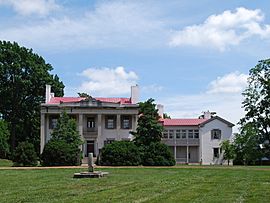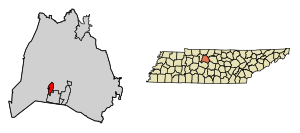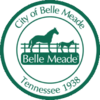Belle Meade, Tennessee facts for kids
Quick facts for kids
Belle Meade
|
|||||
|---|---|---|---|---|---|

The namesake of Belle Meade, Belle Meade Plantation
|
|||||
|
|||||

Location of Belle Meade in Davidson County, Tennessee.
|
|||||
| Country | United States | ||||
| State | Tennessee | ||||
| County | Davidson | ||||
| Area | |||||
| • Total | 3.07 sq mi (7.95 km2) | ||||
| • Land | 3.07 sq mi (7.95 km2) | ||||
| • Water | 0.00 sq mi (0.00 km2) | ||||
| Elevation | 560 ft (170 m) | ||||
| Population
(2020)
|
|||||
| • Total | 2,901 | ||||
| • Density | 944.95/sq mi (364.83/km2) | ||||
| Time zone | UTC-6 (Central (CST)) | ||||
| • Summer (DST) | UTC-5 (CDT) | ||||
| FIPS code | 47-04620 | ||||
| GNIS feature ID | 1305087 | ||||
Belle Meade is a small city in Davidson County, Tennessee. It covers about 3.1 square miles (7.95 square kilometers). In 2020, about 2,901 people lived there.
Belle Meade is special because it acts like its own city with its own rules, city hall, and police. But it also works closely with the larger Nashville government. The city was built on land that used to be a big farm called Belle Meade Plantation. Today, it has many homes, tree-lined streets, and wooded areas. People who live in Belle Meade often have higher incomes compared to the average in the U.S.
The city's story began in 1807. That's when John Harding bought land near Richland Creek. He named his property Belle Meade, which means "beautiful meadow" in French. Over time, workers built a large house and started a horse breeding farm and cotton plantation there. They also ran businesses like a mill and a blacksmith shop.
John Harding's son, William Giles Harding, took over the estate in 1839. Later, his daughter's husband, William Hicks Jackson, helped the estate become famous worldwide for its horses. By 1906, the Harding family had to sell Belle Meade because of money problems. The Belle Meade Land Company then bought the land and started building the neighborhood that became the City of Belle Meade in 1938. The old mansion became a museum. It was added to the National Register of Historic Places in 1969.
Contents
History of Belle Meade
The city of Belle Meade gets its name from the Belle Meade Plantation. This large farm once covered about 5,300 acres (2,145 hectares). It was started by John Harding. His son, William Giles Harding, inherited 1,200 acres. Before the Civil War, William Harding made the property much bigger and built a new mansion. This work was done by 136 enslaved African people.
In 1901, Harding's family members started the Belle Meade Country Club here.
Because of money problems, the Belle Meade Estate sold the mansion and 2,200 acres in 1906. Jacob McGavock Dickinson, a lawyer for a railroad company, bought it. He later became the United States Secretary of War.
In 1906, Jacob Dickinson and others started the Belle Meade Land Company. They hired Ossian Cole Simonds to help design the new community. In 1910, Luke Lea and others bought the company. They began building the main streets of Belle Meade, like Jackson Boulevard. Other developers also built new areas like Deer Park.
In 1963, Belle Meade became part of the larger Nashville-Davidson County government. However, it still kept its status as an independent city. This means people living in Belle Meade pay taxes to both the Metro government and the City of Belle Meade. Belle Meade has its own street signs, police, mayor, and city hall. Many houses in the city have been listed on the National Register of Historic Places since 2004.
Geography of Belle Meade
Belle Meade covers about 3.1 square miles (7.95 square kilometers), and all of it is land. Belle Meade Boulevard leads to the main entrance of Percy Warner Park, which is a very large park. Richland Creek also flows through the area.
People in Belle Meade (Demographics)
| Historical population | |||
|---|---|---|---|
| Census | Pop. | %± | |
| 1940 | 2,061 | — | |
| 1950 | 2,831 | 37.4% | |
| 1960 | 3,082 | 8.9% | |
| 1970 | 2,933 | −4.8% | |
| 1980 | 3,182 | 8.5% | |
| 1990 | 2,839 | −10.8% | |
| 2000 | 2,943 | 3.7% | |
| 2010 | 2,912 | −1.1% | |
| 2020 | 2,901 | −0.4% | |
| Sources: | |||
2020 Census Information
| Race | Number | Percentage |
|---|---|---|
| White (non-Hispanic) | 2,758 | 95.07% |
| Black or African American (non-Hispanic) | 6 | 0.21% |
| Native American | 1 | 0.03% |
| Asian | 21 | 0.72% |
| Other/Mixed | 63 | 2.17% |
| Hispanic or Latino | 52 | 1.79% |
In 2020, there were 2,901 people living in Belle Meade. There were 853 households and 748 families.
2010 Census Information
In 2010, there were 2,912 people living in the city. Most residents were White (98.2%). A small number of people were African American, Native American, or Asian. About 0.8% of the population was Hispanic or Latino.
There were 1,074 households. Many households (37.7%) had children under 18. Most households (77.2%) were married couples. The average household had 2.71 people.
The population was spread out by age. About 30.9% were under 20 years old. Many people (35.5%) were between 45 and 64 years old. About 18.5% were 65 or older. The average age was 47.1 years.
Belle Meade is known for having a high average income. The average income for a household was about $195,208. This is one of the highest in Tennessee and the nation.
Economy of Belle Meade
The main jobs and businesses in Belle Meade are in a few key areas. Many people work in Healthcare and Social Assistance. Other important fields include Professional, Scientific, and Tech Services, and Finance and Insurance.
The most common jobs for people living in Belle Meade are in Management, Sales, and Health Care. There are also people working in Legal jobs, Arts and Recreation, and Education.
Arts and Culture in Belle Meade
Belle Meade Plantation is a popular place to visit. It was built in the 1820s by John Harding. You can see historical buildings there, including the old log cabin and a Victorian-style mansion. The mansion has a museum with items that belonged to the Harding family.
Cheekwood Estate and Gardens is another big attraction. It's a large botanical garden and art museum. It used to be the home of Leslie and Mabel Cheek. Cheekwood is just outside Belle Meade. It hosts art shows, festivals, and family events all year.
Parks and Recreation in Belle Meade
Belle Meade Country Club is a private club for members only. It has an 18-hole golf course, tennis courts, and a swimming pool. Getting a membership can be difficult. The golf course was designed by Donald J. Ross and later updated by other architects.
Percy Warner Golf Course is a 9-hole golf course. It is located in Percy Warner Park, near Belle Meade. It's a public course where you can play without a reservation. Fees for playing and renting carts are affordable.
Percy Warner Park and Edwin Warner Park are two large parks that connect. People in Nashville often call them "The Warner Parks." The northern part of Percy Warner Park is right next to Belle Meade. Together, the parks cover more than 3,100 acres. They have picnic areas, a nature center, trails for hiking and biking, sports fields, and horse trails.
These parks are also historically important. They are listed on the National Register of Historic Places. In 1927, Colonel Luke Lea and his wife, Percie Warner, gave almost 900 acres of land to create the park. Much of this land came from the old Belle Meade Plantation. The famous stone gates and eagles at the park entrance were added in 1932. The beautiful stone staircase called The Allee was built in the 1930s.
The park also has old cemeteries from before the Civil War. There's also a World War I memorial. It honors Camp Andrew Jackson, a training site for soldiers during WWI.
Parmer Park is a local park with open green space. It has basketball courts, playground equipment, and a baseball field. The entrance of an old school that burned down in the 1980s still stands in the middle of the park.
Education in Belle Meade
Belle Meade is part of the Metropolitan Nashville Public Schools District. There are no public schools directly inside the city. However, several public schools are very close by. These include Julia Green Elementary (for younger students), H.G. Hill Middle School, and Hillwood Comp High School.
Many private schools are also located near Belle Meade:
- Harding Academy is a private school for students from Pre-Kindergarten to 8th grade. It was started in 1971. The school now welcomes all students and does not discriminate.
- Harpeth Hall School is a private school for girls in grades 5 through 12. It was founded in 1865. Students can join many clubs and activities.
- Montgomery Bell Academy is a private school for boys in grades 7 through 12. It was founded in 1867.
- The Ensworth School has a campus for its younger and middle school students near Belle Meade. It offers many activities, including swimming and ice hockey.
Several colleges and universities are also just a few miles from Belle Meade. These include Vanderbilt University, Nashville State Community College, and Aquinas College.
City Services (Infrastructure)
Belle Meade has its own Public Works Department. This department handles trash pickup and recycling services. They also help with yard waste like brush and wood chips. The city also manages its own sewer system.
The city has its own police department. Besides regular police work, they offer other services. These include a neighborhood watch program and fingerprinting. They also collect old prescription drugs and can check on your house when you are out of town.
See also
 In Spanish: Belle Meade (Tennessee) para niños
In Spanish: Belle Meade (Tennessee) para niños




